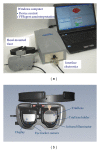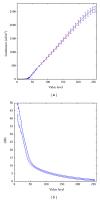Testing of visual field with virtual reality goggles in manual and visual grasp modes
- PMID: 25050326
- PMCID: PMC4090491
- DOI: 10.1155/2014/206082
Testing of visual field with virtual reality goggles in manual and visual grasp modes
Abstract
Automated perimetry is used for the assessment of visual function in a variety of ophthalmic and neurologic diseases. We report development and clinical testing of a compact, head-mounted, and eye-tracking perimeter (VirtualEye) that provides a more comfortable test environment than the standard instrumentation. VirtualEye performs the equivalent of a full threshold 24-2 visual field in two modes: (1) manual, with patient response registered with a mouse click, and (2) visual grasp, where the eye tracker senses change in gaze direction as evidence of target acquisition. 59 patients successfully completed the test in manual mode and 40 in visual grasp mode, with 59 undergoing the standard Humphrey field analyzer (HFA) testing. Large visual field defects were reliably detected by VirtualEye. Point-by-point comparison between the results obtained with the different modalities indicates: (1) minimal systematic differences between measurements taken in visual grasp and manual modes, (2) the average standard deviation of the difference distributions of about 5 dB, and (3) a systematic shift (of 4-6 dB) to lower sensitivities for VirtualEye device, observed mostly in high dB range. The usability survey suggested patients' acceptance of the head-mounted device. The study appears to validate the concepts of a head-mounted perimeter and the visual grasp mode.
Figures







References
-
- Zadnik K. The Ocular Examination. Measurements and Findings. Philadelphia, Pa, USA: WB Saunders; 1997.
-
- Anderson DR, Patella VM. Automated Static Perimetry. 2nd edition. St. Louis, Mo, USA: Mosby; 1999.
-
- Delgado MF, Nguyen NTA, Cox TA, et al. Automated perimetry: a report by the American Academy of Ophthalmology. Ophthalmology. 2002;109(12):2362–2374. - PubMed
-
- McKendrick AM. Recent developments in perimetry: test stimuli and procedures. Clinical and Experimental Optometry. 2005;88(2):73–80. - PubMed
-
- Iester M, Altieri M, Vittone P, Calabria G, Zingirian M, Traverso CE. Detection of glaucomatous visual field defect by nonconventional perimetry. American Journal of Ophthalmology. 2003;135(1):35–39. - PubMed
Publication types
MeSH terms
Grants and funding
LinkOut - more resources
Full Text Sources
Other Literature Sources
Miscellaneous

